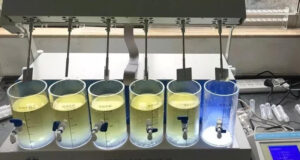Specific operation method:
Equipment used: beaker, coagulation test stirrer, measuring cylinder, raw water sample, turbidimeter, pH value, and thermometer;
* Determine the characteristics of the raw water (such as the turbidity, pH, temperature, etc.) and record;
* Take six 1000ML beakers and put the same amount of raw water sample;
* Put six beakers on the fixed position of the coagulation test stirrer, set the same speed and time;
* Add different amounts of coagulant to the dosing test tube one by one, and start the coagulation test stirrer;
* After mixing, turn off the coagulation test stirrer. Observe the phenomenon of atomization in different beakers;
* After 10 minutes, take 50ML of beakers to surface water for testing;
* Immediately use the turbidimeter to measure the turbidity data of the sample and record the comparison;
* The group with the least turbidity is the best dosage for this experiment.
* If the effect is not satisfactory, you need to adjust the dosage range.
* The pH value of raw water is controlled between 6-9.
Of course, there are many ways to determine the dosage of the coagulation agent.
It is worth mentioning that the easiest way to calculate the dosage is to refer to the information of already built sewage treatment plants with similar water quality and make appropriate adjustments based on the former.
Calculation of coagulant dosage: T=aQ/1000
T——daily coagulant dosage (kg/d)
a——Maximum dosage of coagulant per unit (mg/L)
Q——Daily treated water volume (m³/d)


Leave A Comment